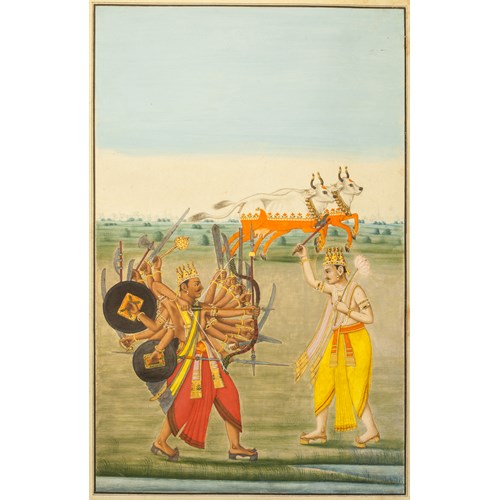Marketplace
A Qajar Large Silk and Metal Thread Embroidered Panel
A Qajar Large Silk and Metal Thread Embroidered Panel
Period 19th century
Origin Qajar Iran
Dimension 83.5 x 138 cm (32⁷/₈ x 54³/₈ inches)
This crimson velvet embroidery is adorned with birds and voluptuous flowers. In the borders are undulating vines with heavy leaves and blossoms scroll. In the central field, the lozenge- and leaf-shaped cartouches bear inscriptions in Persian.
The two leaf-shaped cartouches bear the same inscription:
کلید گنج سعادت بدست سلطنت است.
Kilīd-i ganj-i sa’ādat be-dast-i ṣulṭanat ast.
The key of fortune is in the hand of the soverign
The central lozenge-shape cartouche is not fully deciphered.
Foil-wrapped, silk and coloured cotton threads are used in the embroidery of this textile. The three-dimensional couching of threads combined with the tactile ground fabric creates a richly textured embroidery.
Comparative material:
Victoria and Albert Museum, London (951-1889); The Textile Museum, Washington, D.C. (1977.37.18)
Reference:
Bier, Carol. Woven from the Soul, Spun from the Heart : Textile Arts of Safavid and Qajar Iran, 16th-19th Centuries. Washington, D.C: Textile Museum, 1987.
Stock No.: A5295
The two leaf-shaped cartouches bear the same inscription:
کلید گنج سعادت بدست سلطنت است.
Kilīd-i ganj-i sa’ādat be-dast-i ṣulṭanat ast.
The key of fortune is in the hand of the soverign
The central lozenge-shape cartouche is not fully deciphered.
Foil-wrapped, silk and coloured cotton threads are used in the embroidery of this textile. The three-dimensional couching of threads combined with the tactile ground fabric creates a richly textured embroidery.
Comparative material:
Victoria and Albert Museum, London (951-1889); The Textile Museum, Washington, D.C. (1977.37.18)
Reference:
Bier, Carol. Woven from the Soul, Spun from the Heart : Textile Arts of Safavid and Qajar Iran, 16th-19th Centuries. Washington, D.C: Textile Museum, 1987.
Stock No.: A5295
Period: 19th century
Origin: Qajar Iran
Dimension: 83.5 x 138 cm (32⁷/₈ x 54³/₈ inches)
Provenance: Provenance: From the collection of the Countess Amalia Canonica, from the beginning of 20th century; by inheritance.
More artworks from the Gallery









